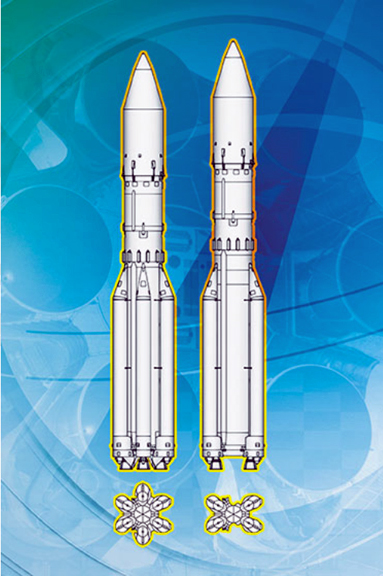
Cost effective GEO launch solutions for smallsats and medium satellite class ranges are becoming key points for launch vehicle company rocket development to address changing market needs.

In example, International Launch Services (ILS) has just announced a product line extension of their Proton Breeze M commercial launch vehicle that is designed to expand the addressable GEO market for 3 to 5 metric ton satellites. Designated as “Proton Variants,” these two additional vehicles will be optimized 2-stage versions of the time tested and flight proven Proton Breeze M launch system for exclusive commercial use by ILS.
The Proton Variants initial launch capability will be established starting in 2018 with the “Proton Medium” vehicle launching from Pad 24 at the Baikonur Cosmodrome. The 2-stage Proton Medium Variant will have a 4 meter payload fairing and use the standard Proton M configuration with six engines on the first stage. This version will be followed in 2019 by the “Proton Light” Variant. The 2-stage Proton Light will have a 4 meter payload fairing but feature only four engines on the first stage. Both variants will maintain use of the flight proven and time tested Breeze M upper stage for spacecraft insertion.
The new Proton Variant commercial product line development is a result of ILS and Khrunichev working closely with customers and spacecraft manufacturers to find mutually beneficial launch solutions that are optimized for the commercial market, and aligned with its projected growth.
ILS President, Kirk Pysher, reported that ILS and Khrunichev are using the robust capability of the Proton Breeze M vehicle to better align the firm's product offerings with changing market conditions, while simultaneously lowering the costs with a service that can address the entire commercial LEO, MEO and GEO marketplace. Over time, the Proton launch vehicle’s performance has been enhanced to keep up with the demand for increased performance to address the trend of satellite mass growth to accommodate the heavy, High-Throughput Satellite (HTS) designs. Electric and hybrid spacecraft propulsion has changed that trend and customers want the benefits of the heritage Proton Breeze M launch vehicle design but need the flexibility and cost benefits to align the vehicle’s performance to current spacecraft requirements.
Jim Kramer, who is responsible for the commercial development of the Proton Variant line as the firm's Vice President of Engineering and Mission Assurance, added that the design aspects of the variants were directly derived from the requirements of customers to include reducing the basic cost of the vehicle, improving the design reliability and addressing the 3 to 5 metric ton satellite performance range. With this in mind, the development of this expanded Proton product line was simplified by restricting the vehicle modifications to minimize changes to existing Proton propulsion and guidance, navigation and control (GNC) systems while making full use of the heritage flight-proven elements of the Proton Breeze M system. This is achieved through the elimination of the existing second stage, minor lengthening of the remaining two booster stages and no modifications to the Breeze M upper stage. The removal of the existing second stage with four engines for the Proton Medium and the additional elimination of two first stage engines and associated tanks for the Proton Light provides a simplified and elegant design solution to reduce cost and increase the design reliability of the expanded Proton product line.
According to Khrunichev Director General, Andrey Kalinovskiy, the Proton Variant product line will complement other launch service providers’ offerings to allow additional access to space for global operators, while increasing the addressable commercial market for Proton. As this new product line is essentially a commercial offspring of Proton Breeze M, Khrunichev is able to optimize the design, production and operational efficiencies and transfer those savings on to customers. The variants will be produced for ILS using a commercial specification that will include additional oversight into the design and production of the Proton Variants. This offering will serve customers well and will help to ensure timely delivery and assured access to space for commercial customer’s assets.
The composition of the new Proton Variant Launch System is identical to the Proton Breeze M and includes the following components:
- 2-Stage Proton Launch Vehicle;
- Dedicated Launch Vehicle processing facilities;
- Launch Complex (launch operations are planned from Proton M Launch Pad 24 at Baikonur Cosmodrome);
- Specialized and dedicated launch site transport system
The following is the lift capability of each of the Proton vehicles with the 4-meter payload fairing:
- Proton Breeze M launch performance is 6300 kg to 1500 meters/second (m/s) ΔV
- Proton Medium launch performance is a minimum of 5000 kg to 1500 m/s ΔV
- Proton Light launch performance is a minimum of 3600 kg to 1500 m/s ΔV
The proven Proton Breeze M launch vehicle is a three stage vehicle with a restartable main engine on the Breeze M upper stage. The vehicle has been in service since 1965 with more than 410 launches to date for the Russian Federal government and global commercial satellite operators. Over time, the vehicle has experienced phased improvements with lift capability of up to 6,300 kg to reference GTO and 6,500 kg to SSTO at 1500 m/s. The Proton vehicle’s Breeze M upper stage allows for optimizing each mission and maximizing projected in orbit lifetime for single or multiple satellites to LEO, MEO, HEO, GTO, GSO and SSTO.

